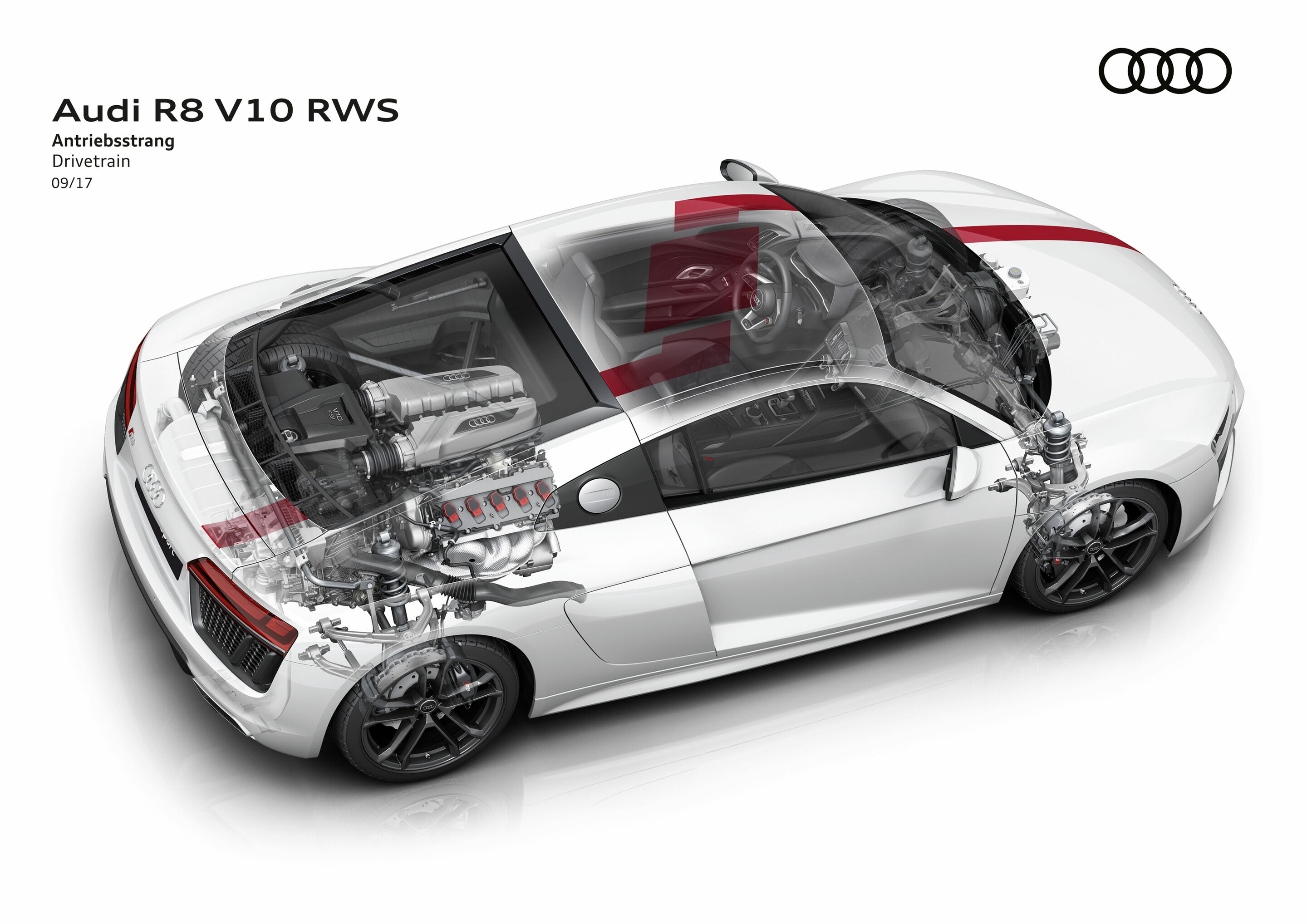Power transmission and suspension
Back to overviewBehind the ten-cylinder engine is a 7-speed S tronic. The commands are transmitted purely electronically – shift by wire. The driver can change gears via the selector lever or the steering wheel rockers, or alternatively, they can allow the S tronic to switch to programs D and S itself. At the push of a button, the Launch Control Program controls the engagement of the clutch at about 4,500 rpm from a standing start – thus transferring the power of the V10 to the road with controlled tire slip.
The S tronic dual clutch transmission is very compact. Its thermal management system, which cooperates with the engine, uses an oil-water heat exchanger mounted on the gearbox. The mechatronic unit is constructed as a separate block, and actuates and lubricates the high-tech gearbox. Just one oil pump is enough to supply the wheel sets, clutches and the integrated limited slip differential.
The purely mechanical rear-axle differential lock improves the traction and driving dynamics – it has a 25% lock effect on traction and 45% on thrust. This makes it precisely tailored to the dynamic and puristic character of the new Audi R8 V10 RWS (combined fuel consumption in l/100 km: 12.6–12.4 [18.7–19.0 US mpg], combined CO2 emissions in g/km: 286–283 [460.3–455.4 g/mi]). The mid-mounted engine is positioned close to the vertical axis in the center of the vehicle so that the sports car remains stable on the road, even during rapid changes of direction. The axle load distribution is 40.6:59.4 (Spyder: 40.4:59.6).
Adjusted suspension for maximum driving pleasure
The tailoring of the suspension and driving dynamics to the rear-wheel drive concept ensures maximum driving pleasure. The specific suspension setup and the control systems enable controlled drifts when the driver selects “dynamic” mode in the Audi drive select dynamic handling system and activates ESC sport mode. When the limit is reached, the ESC stability control will engage safely.
The aluminum double wishbone suspension – a classic design principle from motorsport – guides the wheels. Rubber-metal bearings transfers the lateral forces into the body while ensuring good elasticity in the longitudinal direction. The track is 1,599 millimeters (63.0 in) on the rear axle, and 1,638 millimeters (64.5 in) on the front axle.
The new electromechanical power steering tuned for the rear-wheel drive enables precise handling. It provides differentiated feedback from the road and at the same time saves a significant amount of energy compared to a hydraulic steering system. It has a steering ratio of 15.7:1, and the effect of the power steering is based on the speed being driven and the mode selected in Audi drive select.
The new Audi R8 V10 RWS (combined fuel consumption in l/100 km: 12.6–12.4 [18.7–19.0 US mpg], combined CO2 emissions in g/km: 286–283 [460.3–455.4 g/mi])is fitted as standard with 19-inch forged aluminum wheels with a five-spoke V-design painted in black. The front tires are 245/35 and the rear tires are 295/35. Direct tire pressure monitoring comes as standard, along with temperature monitoring.
Large brakes are located behind the wheels. The standard steel discs have wavy contours (wave design), which makes them particularly lightweight. They are internally ventilated and perforated. Stainless steel pins bind the discs to the aluminum chambers, which prevent the transfer of temperature peaks. The front axle features eight-piston fixed calipers and discs with a diameter of 365 millimeters (14.4 in), while the rear axle features four-piston calipers and discs with a diameter of 356 millimeters (14.0 in). The electromechanical parking brake is applied to two separate floating calipers.
All terms marked in the text are explained in detail in the technology lexicon at www.audi-mediacenter.com/en/technology-lexicon.
The equipment, data and prices specified in this document refer to the model range offered in Germany. Subject to change without notice; errors and omissions excepted.
